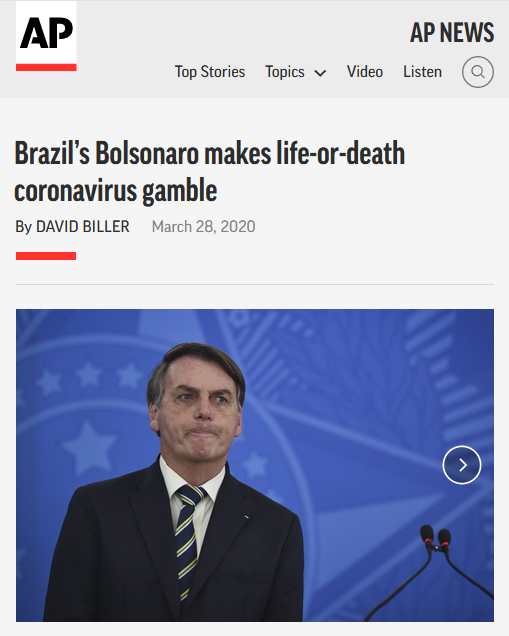ACTION ALERT: Dangerous Misinformation From AP
Jim Naureckas


AP's report on Brazilian President Jair Bolsonaro's downplaying of Covid-19 called it a "life-or-death coronavirus gamble"—but AP's standard description of the disease, included in this and many other stories, offers similar false reassurance.
There's a boilerplate passage that the Associated Press likes to insert into its stories on the coronavirus (e.g., 3/28/20, 2/29/30, 3/30/20). Under the headline "What You Need to Know About the Virus Outbreak" ( 3/30/20), it's the first language after the heading "What You Need to Know." And what AP thinks you need to know is this:
For most people, the coronavirus causes mild or moderate symptoms, such as fever and cough that clear up in two to three weeks. For some, especially older adults and people with existing health problems, it can cause more severe illness, including pneumonia, and death. The vast majority of people recover.
Well, that sounds reassuring, doesn't it? Especially if you're not an older adult or a person with existing health problems, you might even be thinking—what's the big deal?
First of all, "existing health problems" are extremely common. Half of American adults have high blood pressure (American Heart Association, 1/31/18)—one of the most prevalent pre-existing conditions among Covid-19 fatalities, according to a study of Italian deaths from the disease ( Bloomberg, 3/18/20). Other common illnesses associated with coronavirus deaths include diabetes, which affects 9% of American adults (CDC, 7/18/17), and coronary heart disease, which affects 7% (CDC, 12/2/19). Altogether, according to the federal Centers for Medicare & Medicaid Services, up to half of all non-elderly Americans have pre-existing health conditions. So the "some" that are liable to "more severe illness" may amount to "most."
How does that work out in reality? A Centers for Disease Control report ( 3/26/20) looked at domestically acquired cases of Covid-19 in the US from February 12 to March 16—a total of 4,226 cases. (As of March 30, there have been 142,746 cases of the rapidly spreading disease in the US.)
Of the 2,449 patients whose ages were known, 70% were under 65. In this group, the hospitalization rate for patients 20–44 was at least 14%; for patients 45–54 and 55–64, it was at least 21%. Among the elderly, the hospitalization rate was about half again as high, rising to a minimum of 31% among those 85 and older. Only patients under 20 had a hospitalization rate comparable to that of influenza, with at least 1.6% of cases in this group going to the hospital.
Almost a quarter of the hospitalized patients required intensive care. Of these, nearly half were under 65, with 36% of the intensive care Covid-19 patients aged 45–64 and 12% aged 20–44. Only patients under 20, the report found, never needed intensive care. (Some of those who require intensive care may never recover full lung capacity— ABC, 3/28/20.)
These figures need to be understood in the context of the limits of the US hospital system, which has less than a million beds and less than 80,000 intensive care beds. Even a small fraction of adults—elderly or otherwise—catching the coronavirus would risk totally overwhelming US healthcare.
The CDC's summary of its data sends a much different message than AP's boilerplate:
Covid-19 can result in severe disease, including hospitalization, admission to an intensive care unit and death, especially among older adults. Everyone can take actions, such as social distancing, to help slow the spread of Covid-19 and protect older adults from severe illness.
As for AP's claim that "the vast majority of people recover"—of the 142,746 US cases to date, 4,562 have recovered and 2,489 have died; the outcome of the rest has yet to be determined. In China, the only country where a major outbreak seems to have brought under control, 93% of 81,470 cases have been resolved, and of the resolved cases, 4% were fatal. By way of comparison—which AP's glib assurance to the "vast majority" fails to provide—the seasonal flu kills 0.1%–0.2% of people who come down with it.
It's possible that the eventual death rate from Covid-19 will be considerably lower than 1 in 25; outside of the epidemic's epicenter in Hubei province, where the healthcare system was initially overwhelmed, the Chinese death rate for resolved cases is 0.9%.
But in China, officials moved quickly to pause economic activity, and tested aggressively so asymptomatic carriers could be identified and isolated, thus preventing hospitals from being overwhelmed on a national level. The United States has so far failed to follow this example—and our major national news service lulling readers into a false sense of security delays the time when we will begin to do so.
ACTION: Please tell the Associated Press to include a serious warning about the dangers of Covid-19, based on CDC guidelines, in its standard description of the coronavirus.
CONTACT:
Please remember that respectful communication is the most effective. Feel free to leave a copy of your message to AP in the comments thread of this post.
Featured Image: AP photo (3/30/20) of a hospital nurse in Bergamo, Italy.
|




No comments:
Post a Comment
Note: Only a member of this blog may post a comment.